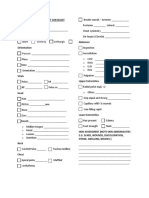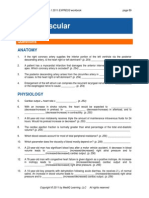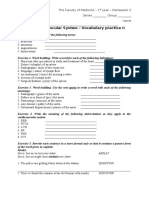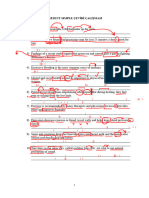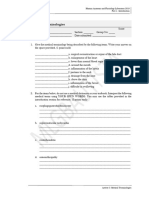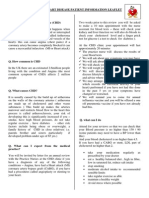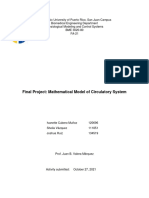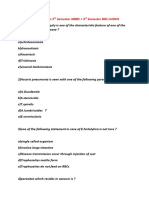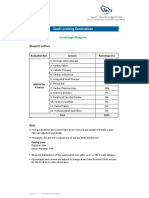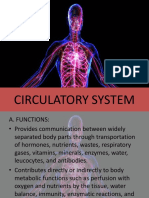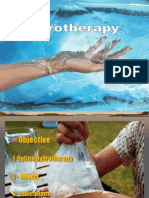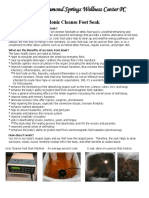Cardio Workbook
Cardio Workbook
Uploaded by
MedStudent MedStudentCopyright:
Available Formats
Cardio Workbook
Cardio Workbook
Uploaded by
MedStudent MedStudentOriginal Title
Copyright
Available Formats
Share this document
Did you find this document useful?
Is this content inappropriate?
Copyright:
Available Formats
Cardio Workbook
Cardio Workbook
Uploaded by
MedStudent MedStudentCopyright:
Available Formats
First Aid Express 2016 workbook: CARDIOVASCULAR page 1
Cardiovascular
How to Use the Workbook with the Videos
Using this table as a guide, read the Facts in First Aid for the USMLE Step 1 2016,
watch the corresponding First Aid Express 2016 videos, and then answer the workbook
questions.
Facts in First Aid for Corresponding First Aid Workbook
the USMLE Step 1 2016 Express 2016 video questions
262.1–264.2 Embryology (3 videos) 1–7
265.1–281.2 Anatomy & Physiology (13 videos) 8–49
282.1–297.1 Pathology (14 videos) 50–89
298.1–304.2 Pharmacology (6 videos) 90–110
Copyright © 2016 by MedIQ Learning, LLC All rights reserved v1.0
page 2 First Aid Express 2016 workbook: CARDIOVASCULAR
Questions
EMBRYOLOGY
1. In the embryonic heart, the right common cardinal vein and the right anterior cardinal vein jointly
give rise to which vein in the adult? (p 262)
________________________________________________
2. Which embryonic shunt diverts oxygenated blood from the inferior vena cava into the left atrium? (p
262) __________________________________________________________________________
3. Which two cardiac structures are created by migration of neural crest cells? (p 263) ____________
______________________________________________________________________________
4. Which embryonic shunt directs oxygenated blood around the hepatic circulation? (p 264) ________
______________________________________________________________________________
5. Which embryonic shunt bypasses the high-resistance pulmonary circulation? (p 264) __________
______________________________________________________________________________
6. What is the approximate oxygen saturation (%) of the blood returning from the placenta in the
umbilical vein? (p 264) ___________________________________________________________
7. Which drug is commonly used to close the ductus arteriosus? What can be used to keep it open?
(p
264) ________________________________________________________________________
ANATOMY
8. If the right coronary artery supplies the inferior portion of the left ventricle via the posterior
descending artery, is the heart right or left dominant? (p 265)
________________________________________
9. A patient has a myocardial infarction that damages the anterior interventricular septum and the
apex. Which coronary artery is occluded? (p 265)
____________________________________________
10. The posterior descending artery arises from the circumflex artery in _____ (7%/8%/85%) of cases.
Is this heart right or left dominant? (p 265)
______________________________________________
11. Enlargement of the left atrium can compress the recurrent laryngeal nerve to cause
______________________, or the esophagus to cause ______________________. (p 265)
Copyright © 2016 by MedIQ Learning, LLC All rights reserved v1.0
First Aid Express 2016 workbook: CARDIOVASCULAR page 3
Copyright © 2016 by MedIQ Learning, LLC All rights reserved v1.0
page 4 First Aid Express 2016 workbook: CARDIOVASCULAR
PHYSIOLOGY
12. Cardiac output = heart rate x ________________________. (p 266)
13. With an increase in stroke volume, the heart would be expected to ______________
(decrease/increase) in preload, to _______________ (decrease/increase) in afterload, and to
_______________ (decrease/increase) in contractility. (p 267)
14. A 60-year-old man receives an intravenous injection of norepinepherine. Would his contractility
increase or decrease? (p 267) _____________________________________________________
15. Write the equation for calculating ejection fraction (p 267) ________________________________
16. Which blood vessels account for most of total peripheral resistance? (p 268)__________________
17. Which parameter does the viscosity of blood mostly depend on? (p 268) ____________________
18. A 23-year-old man has significant blood loss after a motor vehicle accident. A decrease in blood
volume leads to _______________ (increased/decreased) right atrial pressure and to
_______________ (increased/decreased) cardiac output. (p 269)
19. A 76-year-old man with congestive heart failure is given digoxin as a positive inotrope. An increase
in inotropy leads to ____________________ (increased/decreased) cardiac output and to
____________________ (increased/decreased) right atrial pressure. (p 269)
20. A 10-year-old boy presents with dehydration following acute diarrhea. He receives 2 liters of normal
saline. An increase in blood volume leads to ________________________ (increased/decreased)
right atrial pressure and to __________________________ (increased/decreased) cardiac output.
(p 269)
Copyright © 2016 by MedIQ Learning, LLC All rights reserved v1.0
First Aid Express 2016 workbook: CARDIOVASCULAR page 5
21. Fill in the blanks A–D with the correct valvular event that occurs at each stage of the left ventricular
cardiac cycle. Then fill in the blanks 1–5 with the correct phase of the left ventricular cardiac cycle.
(p 270)
A. ____________________________ 1. ____________________________
B. ____________________________ 2. ____________________________
C. ____________________________ 3. ____________________________
D. ____________________________ 4. ____________________________
5. ____________________________
Copyright © 2016 by MedIQ Learning, LLC All rights reserved v1.0
page 6 First Aid Express 2016 workbook: CARDIOVASCULAR
22. Fill in the blanks A–N with the correct heart sound, jugular venous pulse waveform, or ECG
waveform. Specify the cause of each. (Numbers refer to numbers in image in question 21.) (p 270)
A. ____________________________ H. ____________________________
B. ____________________________ I. _____________________________
C. ____________________________ J. _____________________________
D. ____________________________ K. _____________________________
E. ____________________________ L. _____________________________
F. ____________________________ M. _____________________________
G. ____________________________ N. _____________________________
23. In normal splitting of the S2 heart sound, the pulmonic valve closes later during inspiration due to
_______________ (increased/decreased) blood flow over the pulmonic valve, and the aortic valve
closes earlier during inspiration due to _______________ (increased/decreased) blood delivery to
the left heart. (p 271)
24. On auscultation of a patient with an atrial septal defect during inspiration, does the time between
pulmonic and aortic valvular closure increase, decrease, or stay the same? (p 271) ____________
______________________________________________________________________________
Copyright © 2016 by MedIQ Learning, LLC All rights reserved v1.0
First Aid Express 2016 workbook: CARDIOVASCULAR page 7
25. Fill in the blanks A-E with the correct auscultation site. (p 272)
A. ____________________________ D. ______________________________
B. ____________________________ E. ______________________________
C. ____________________________
26. During physical examination, what diagnostic sign might be observed in the neck of a patient with
right heart failure? (pp 272-273) ____________________________________________________
27. Name three pathological processes that can cause mitral regurgitation. (p 273) ________________
______________________________________________________________________________
28. Name four pathological processes that can cause aortic regurgitation. (p 273) _______________
______________________________________________________________________________
29. When listening to a patient’s heart, you hear a harsh holosystolic murmur at the apex that does not
increase in intensity with inspiration. You also notice that it radiates to the left axilla. What is the
most likely cause of this murmur? (p 273)
__________________________________________________
30. Which murmur is often caused by age-related calcification? (p 273) ________________________
31. How is cardiac myocyte physiology different from that in skeletal muscle? (p 274) _____________
______________________________________________________________________________
______________________________________________________________________________
Copyright © 2016 by MedIQ Learning, LLC All rights reserved v1.0
page 8 First Aid Express 2016 workbook: CARDIOVASCULAR
32. Fill in the blanks (A–E) with the correct phase of the myocardial action potential and the ionic
current responsible for each phase. (p 274)
A. ____________________________ D.
______________________________
B. ____________________________ E. ______________________________
C. ____________________________
33. Fill in the blanks A–C with the correct phase of the pacemaker action potential and the ionic current
responsible for each phase. (p. 275)
A. ____________________________ B. ______________________________
C. _____________________________
Copyright © 2016 by MedIQ Learning, LLC All rights reserved v1.0
First Aid Express 2016 workbook: CARDIOVASCULAR page 9
34. As compared with the myocardial action potential, which phases are absent from the pacemaker
potential? (p 275) _______________________________________________________________
______________________________________________________________________________
35. A 67-year-old man has an irregularly irregular ECG tracing during a routine visit to his doctor. What
does the treatment regimen include? (p 276) __________________________________________
______________________________________________________________________________
36. The ECG tracing of a 73-year-old woman shows a "sawtooth" pattern. Which three classes of
antiarrhythmics could be given to treat her condition? (p 276) _____________________________
______________________________________________________________________________
37. Progressive lengthening of the PR interval takes place in _______________ (Mobitz type I/Mobitz
type II/both Mobitz type I and type II) heart block. (p 276)
38. An ECG shows rapid high-amplitude activity but no identifiable waveforms. What is the most likely
diagnosis? (p 276) _______________________________________________________________
39. List some potential dangerous sequelae of torsades de pointes? (p 277) ____________________
______________________________________________________________________________
40. A 65-year-old man presents with an ECG tracing that displays P waves and QRS complexes that
occur independently of each other. Which therapeutic intervention would be most appropriate?
(p 278) ________________________________________________________________________
41. Which infectious disease can cause third-degree heart block? (p 278) ______________________
42. What chemical changes of blood elicit a response from peripheral chemoreceptors? How do central
chemoreceptors differ? (p 279) _____________________________________________________
______________________________________________________________________________
43. A 25-year-old athlete begins training for the Olympics. As she runs her standard 3 miles, is the
increased oxygen demand of the heart met by increased coronary blood flow or by increased
extraction of oxygen? (p 279) ______________________________________________________
44. In the lungs, what is the physiologic advantage of vasoconstriction in response to hypoxia? (p 280)
______________________________________________________________________________
45. An 80-year-old man with a history of right-sided heart failure presents with bilateral ankle edema. In
terms of capillary fluid exchange, what is the mechanism by which his edema developed? (p 281)
______________________________________________________________________________
______________________________________________________________________________
46. A 55-year-old man with longstanding alcoholic cirrhosis presents with bilateral pedal edema and
ascites. In terms of capillary fluid exchange, what is the mechanism by which his edema
Copyright © 2016 by MedIQ Learning, LLC All rights reserved v1.0
page 10 First Aid Express 2016 workbook: CARDIOVASCULAR
developed? (p 281)
_________________________________________________________________________
47. A 43-year-old woman presents with bilateral pitting leg edema. Laboratory results are remarkable
for high low-density lipoprotein, low albumin, and proteinuria (likely nephrotic syndrome). In terms
of capillary fluid exchange, what is the mechanism by which her edema developed? (p 281)
______________________________________________________________________________
______________________________________________________________________________
______________________________________________________________________________
48. A 50-year-old Ethiopian man presents with severe bilateral leg and scrotal edema due to
elephantiasis. In terms of capillary fluid exchange, what is the mechanism by which his edema
developed? (p 281) _____________________________________________________________
______________________________________________________________________________
49. Describe the pressures in the left ventricle and aorta for a patient with aortic stenosis. (p 281)____
______________________________________________________________________________
______________________________________________________________________________
PATHOLOGY
50. How do neonates with tricuspid atresia remain viable given their severely compromised circulation?
(p 282) ________________________________________________________________________
51. What are the four clinical features of tetralogy of Fallot? (p 282) ___________________________
______________________________________________________________________________
52. What must be present for a fetus with D-transposition of great vessels to remain viable? (p 282)
______________________________________________________________________________
______________________________________________________________________________
53. What physical exam findings are associated with coarctation of the aorta? (p 283)____________
______________________________________________________________________________
______________________________________________________________________________
54. Describe the murmur of patent ductus arteriosus. (p 283) ________________________________
55. Which three cardiac defects are associated with Down syndrome? (p 284) ___________________
______________________________________________________________________________
56. List five risk factors for primary hypertension. (p 284) ____________________________________
Copyright © 2016 by MedIQ Learning, LLC All rights reserved v1.0
First Aid Express 2016 workbook: CARDIOVASCULAR page 11
57. An 80-year-old veteran is told by his physician that he has calcification of his radial arteries and
that the condition is relatively benign. What disease does he have? (p 285)
______________________
______________________________________________________________________________
58. List six complications of atherosclerosis. (p 286) ________________________________________
______________________________________________________________________________
59. A patient presents to the emergency department with tearing chest pain radiating to the back and
dies soon after presentation. What would most likely be seen on x-ray of the chest? What vascular
pathology would most likely be seen at autopsy? (p 287) _________________________________
______________________________________________________________________________
60. At what point is ischemic heart disease given the term "myocardial infarction" rather than "unstable
angina"? (p 287) ________________________________________________________________
______________________________________________________________________________
61. List eight symptoms of a myocardial infarction. (p 288) _________________________________
______________________________________________________________________________
______________________________________________________________________________
62. Describe the time frame for events after a myocardial infarction. (p 288)
A. Coagulative necrosis becomes apparent _________________________________________
B. Contraction bands become apparent ____________________________________________
C. Tissue around infarct shows acute inflammation ___________________________________
D. Hyperemia develops _________________________________________________________
E. Granulation tissue appears ____________________________________________________
F. Contracted scar complete _____________________________________________________
63 After a myocardial infarction, when is the patient at the greatest risk for the development of an
arrhythmia? When is the risk for free wall rupture or interventricular septal rupture the greatest?
When is the risk for ventricular aneurysm the greatest? (p 288) ____________________________
______________________________________________________________________________
64. Six days after having a myocardial infarction, a patient presents with a new-onset murmur. Which
type of murmur is the most likely? (p 288) _____________________________________________
65. ST-segment elevation on an ECG indicates _______________ (subendocardial/transmural)
infarction of the myocardium, but ST-segment depression indicates _______________
(subendocardial/transmural) infarction. (p 289)
66. Which ECG leads are best for diagnosing an infarct of the left anterior descending artery? (p 289)
_____________________________________________________________________________
67. A 16-year-old boy presents for a school physical. Physical examination reveals a 2/6 systolic
murmur at the left sternal border. Upon questioning, he mentions that he has had several fainting
Copyright © 2016 by MedIQ Learning, LLC All rights reserved v1.0
page 12 First Aid Express 2016 workbook: CARDIOVASCULAR
episodes. His father, a former Italian soccer player, had similar episodes and died suddenly at the
age of 25 years. What is this patient's most likely diagnosis? What would a cardiac biopsy
specimen reveal? (p 291) ________________________________________________________
______________________________________________________________________________
68. In heart failure, _________________ (increased/decreased) cardiac output leads to
_______________ (increased decreased) activity of renin-angiotensin-aldosterone, which leads to
_______________ (increased/decreased) systemic venous pressure, and ultimately the physical
finding of ________________ (peripheral/pulmonary) edema. (p 292)
69. In heart failure, _______________ (increased/decreased) left ventricular contractility leads to
_______________ (increased/decreased) pulmonary venous pressure, ultimately leading to
_______________ (peripheral/pulmonary) edema. (p 292)
70. With respect to bacterial endocarditis, what symptoms and signs are represented by the mnemonic
FROM JANE? (p 293) ____________________________________________________________
______________________________________________________________________________
71. Rheumatic fever is secondary to infection by which organism?(p 294) _______________________
72. List the components of the J♥NES mnemonic for rheumatic heart disease. (p 294) ____________
______________________________________________________________________________
______________________________________________________________________________
73. What physical exam findings are associated with cardiac tamponade? (p 294) ________________
_____________________________________________________________________________
______________________________________________________________________________
74. A 70-year-old former prostitute presents with chest pain radiating to the back and worsening
shortness of breath on exertion. Her cardiac enzymes are negative and she has no ST changes on
ECG. An echocardiogram shows aortic regurgitation and a dilated aortic root. Laboratory tests are
significant for a positive rapid plasma reagin. What is the most likely cause of her pain and
shortness of breath? (p 294)
_______________________________________________________________
______________________________________________________________________________
75. Which cardiac tumor may present with multiple syncopal episodes? (p 295) __________________
______________________________________________________________________________
80. Which three clinical findings are associated with Buerger disease? (p 296) __________________
______________________________________________________________________________
Copyright © 2016 by MedIQ Learning, LLC All rights reserved v1.0
First Aid Express 2016 workbook: CARDIOVASCULAR page 13
81. A 7-year-old Japanese child presents with a one-week history of fever, palpable lymph nodes,
erythema of the conjunctiva and tongue, and desquamation of the palms of the hands. What is the
most likely diagnosis? What is the preferred treatment? (p 296) ___________________________
______________________________________________________________________________
82. Which infectious disease is strongly associated with polyarteritis nodosa? (p 296) _____________
______________________________________________________________________________
83. Which arteriographic findings are seen with polyarteritis nodosa? (p 296) ____________________
______________________________________________________________________________
84. A 75-year-old woman presents with new-onset right jaw pain and headache at the right temple.
What is the most likely diagnosis? (p 296)
__________________________________________________
85. Temporal arteritis is associated with what laboratory finding? (p 296) _______________________
86. List eight signs or symptoms of granulomatosis with polyangiitis (Wegener). (p 296) ___________
______________________________________________________________________________
______________________________________________________________________________
87. In microscopic polyangiitis, the patient will test positively for __________ (MPO-ANCA/p-ANCA or
PR3-ANCA/c-ANCA) in the serum. In granulomatosis with polyangiitis (Wegener), the patient will
test positively for __________ (MPO-ANCA/p-ANCA or PR3-ANCA/c-ANCA). (p 296)
88. Patients with Churg-Strauss syndrome usually present with which signs and symptoms? (p 297)
______________________________________________________________________________
89. A 7-year-old boy with a recent viral upper respiratory tract infection now presents with worsening
abdominal and joint pain. Purpura develops on his legs. What is the most likely diagnosis? (p 297)
______________________________________________________________________________
PHARMACOLOGY
90. Why are angiotensin-converting enzyme inhibitors especially important for patients with diabetes
mellitus? (p 298) ________________________________________________________________
91. What two agents are first-line therapy for hypertension in pregnancy? (p 298) ________________
______________________________________________________________________________
92. A patient is started on antihypertensive therapy. One week later he returns, complaining of swollen
ankles and flushed skin. Which class of medication was he likely prescribed? (p 298) _________
______________________________________________________________________________
93. List four adverse effects of nitroglycerin. (p 299) _______________________________________
Copyright © 2016 by MedIQ Learning, LLC All rights reserved v1.0
page 14 First Aid Express 2016 workbook: CARDIOVASCULAR
______________________________________________________________________________
94. What is the effect of nitrates on contractility? What is the effect of nitrates with β-blockers on
contractility? (p 299) _____________________________________________________________
95. By which mechanism can medications reduce angina? (p 299) ____________________________
______________________________________________________________________________
______________________________________________________________________________
96. A 50-year-old man with hypercholesterolemia is deficient in vitamins A, D, E, and K. He also
complains of gastrointestinal discomfort since starting a lipid-lowering agent. Which lipid-lowering
agent is the most likely cause? (p 300) _______________________________________________
97. A patient who recently started taking lovastatin presents with diffuse muscle pain and weakness.
Which laboratory test should be ordered? (p 300) ______________________________________
98. Digoxin inhibits which mechanism of transport in the cell membrane? (p 301) _________________
99. List six ECG findings characteristic of digoxin toxicity. (p 301) _____________________________
______________________________________________________________________________
100. What are the mechanisms of action of cardiac glycosides? (p 301) _________________________
______________________________________________________________________________
101. Facial rash and joint pain develop in a patient who is taking procainamide for an arrhythmia. Anti -
histone antibodies are present in her serum. What is the most likely diagnosis? (p 302)
______________________________________________________________________________
102. Symptoms of headache and tinnitus related to quinidine use are collectively known as (p 302).
______________________________________________________________________________
103. What are the toxicities of β-blockers? (p 303) __________________________________________
______________________________________________________________________________
104. What is the mechanism of action of β-blockers? (p 303) _________________________________
______________________________________________________________________________
105. What three types of testing must be performed periodically for patients who take amiodarone?
(p 303) _______________________________________________________________________
106. What is a potentially fatal adverse effect of ibutilide? (p 303) ______________________________
107. What are the adverse effects of calcium channel blockers? (p 304) _________________________
______________________________________________________________________________
Copyright © 2016 by MedIQ Learning, LLC All rights reserved v1.0
First Aid Express 2016 workbook: CARDIOVASCULAR page 15
108. Which antiarrhythmic is a first-line drug for diagnosing and abolishing supraventricular tachycardia?
(p 304) _______________________________________________________________________
109. Which ion is infused to treat Torsades de pointes and digoxin toxicity? (p 304) ________________
110. Name three toxicities of adenosine. (p 304) ___________________________________________
Copyright © 2016 by MedIQ Learning, LLC All rights reserved v1.0
page 16 First Aid Express 2016 workbook: CARDIOVASCULAR
Answers
EMBRYOLOGY
1. Superior vena cava.
2. Foramen ovale.
3. The ascending aorta and pulmonary trunk are created from the truncus arteriosus.
4. Ductus venosus.
5. Ductus arteriosus.
6. 80%.
7. Indomethacin closes a PDA, whereas prostaglandins can keep it open.
ANATOMY
8. Right dominant.
9. The left anterior descending artery.
10. 8%; left dominant.
11. Hoarseness; dysphagia.
PHYSIOLOGY
12. Stroke volume.
13. Increase; decrease; increase.
14. Increase.
15. EF = SV/EDV = (EDV – ESV) / EDV
16. Arterioles.
17. Hematocrit.
18. Decreased; decreased.
19. Increased; increased.
Copyright © 2016 by MedIQ Learning, LLC All rights reserved v1.0
First Aid Express 2016 workbook: CARDIOVASCULAR page 17
20. Increased; increased.
21. A = Aortic valve closes.
B = aortic valve opens.
C = mitral valve closes.
D = mitral valve opens.
1 = isovolumetric contraction.
2 = systolic ejection.
3 = isovolumetric relaxation.
4 = rapid filling.
5 = reduced filling.
22. A = S4; atrial kick, caused by high atrial pressures and associated with ventricular hypertrophy and
a stiff ventricle.
B = S1; mitral and tricuspid valve closure.
C = S2; aortic and pulmonary valve closure.
D = S3; associated with increased filling pressures, and more common in dilated ventricles.
E = a wave; atrial contraction.
F = c wave; RV contraction (closed tricuspid valve bulging into right atrium).
G = x wave; first down slope of the jugular venous pulse.
H = v wave; increased right atrial pressure due to filling against a closed tricuspid valve.
I = y wave; second down slope of the jugular venous pulse.
J = P wave; atrial depolarization.
K = QRS complex; ventricular depolarization.
L = QRS complex; ventricular depolarization.
M = QRS complex; ventricular depolarization.
N = T wave; ventricular repolarization.
23. Increased; decreased.
24. Stays the same. (Because pressures can equalize across the atrial wall, there is no change in
splitting during inspiration.)
25. A = Aortic area; B = left sternal border; C = pulmonic area; D = tricuspid area; E = mitral area.
26. Elevated jugular venous pressure (causing jugular venous distension on physical examination).
27. Ischemic heart disease, mitral valve prolapse, or left ventricular dilatation.
28. Aortic root dilatation, bicuspid aortic valve, endocarditis, or rheumatic fever.
29. Mitral valve regurgitation.
30. Aortic stenosis.
31. The cardiac muscle action potential has a plateau due to calcium ion influx; cardiac nodal cells
display automaticity by spontaneously depolarizing; and cardiac myocytes are electrically coupled
via gap junctions.
32. A = Phase 0; Na+ current.
B = Phase 1; K+ current.
C = Phase 2; Ca2+ and K+ current.
D = Phase 3; K+ current.
E = Phase 4; K+ current.
Copyright © 2016 by MedIQ Learning, LLC All rights reserved v1.0
page 18 First Aid Express 2016 workbook: CARDIOVASCULAR
33. A = Phase 4; Na+ current.
B = Phase 0; Ca2+ current.
C = Phase 3; K+ current.
34. Phases 1 and 2.
35. Treatment includes rate control, anticoagulation, and possible cardioversion.
36. Class IA, IC, and III antiarrhythmics.
37 Type I. Type I involves progressive lengthening followed by a dropped beat. In type II, dropped
beats occur without progressive lengthening.
38. Ventricular fibrillation.
39. Ventricular fibrillation and death.
40. An implantable pacemaker.
41. Lyme disease.
42. Low PO2 (<60 mm Hg), high PCO2, and low pH of blood; central chemoreceptors are not sensitive
to oxygen.
43. Increased coronary blood flow (the heart always operates with maximal oxygen extraction).
44. This mechanism allows for only well-ventilated areas to remain perfused, optimizing gas exchange.
45. Heart failure results in increased capillary pressure, which causes fluid to move out of the
capillaries and into the interstitial space.
46. Liver failure results in decreased plasma proteins, which decreases plasma colloid oncotic
pressure, and in turn causes fluid to move out of the capillaries and into the interstitial space.
47. Nephrotic syndrome results in proteinuria and subsequent hypoalbuminemia, thus decreasing
plasma colloid oncotic pressure, which in turn causes fluid to move out of the capillaries and into
the interstitial space.
48. Lymphatic obstruction results in increased interstitial fluid colloid osmotic pressure, which causes
fluid to move out of the capillaries and into the interstitial space.
49. In a patient with aortic stenosis, the pressure in the left ventricle is higher than that in the aorta; the
ventricle squeezes blood past a stenotic valve. Thus, the pressure before the valve (the ventricle)
is higher than the pressure after the valve (in the aorta).
PATHOLOGY
50. To maintain viability, both an ASD and a VSD are required for babies with tricuspid atresia.
51. Pulmonary infundibular stenosis, Right ventricular hypertrophy, Overriding aorta, and Ventricular
septal defect. (Remember: PROVe)
52. A shunt must be present, which allows adequate mixing of pulmonary and systemic blood (i.e.,
VSD, ASD, or patent foramen ovale).
Copyright © 2016 by MedIQ Learning, LLC All rights reserved v1.0
First Aid Express 2016 workbook: CARDIOVASCULAR page 19
53. Notched ribs due to increased collateral circulation, hypertension in the upper extremities, and
weak pulses in the lower extremities.
54. Continuous "machine-like" murmur.
55. ASD, VSD, and atrioventricular septal defect.
56. Increased age, obesity, diabetes, smoking, and genetics.
57. Mönckeberg arteriosclerosis.
58. Infarcts, peripheral vascular disease, thrombi, emboli, aneurysms, and ischemia.
59. Mediastinal widening. Longitudinal intraluminal tear forming a false lumen, both of which are
indicative of aortic dissection.
60. When acute thrombosis due to coronary artery atherosclerosis results in myocyte necrosis.
61. Severe retrosternal pain, nausea, vomiting, pain in the left arm, diaphoresis, jaw pain, shortness of
breath, and fatigue.
62. A = 4 hours; B = 12-24 hours; C = 2-4 days; D = 5-10 days; E = 5-10 days; F = 7 weeks.
63. First 4 days; 5-10 days; 7 weeks.
64. Holosystolic murmur of mitral regurgitation, best heard over the apex of the heart.
65. Transmural infarct; subendocardial infarct.
66. Leads V1-V4.
67. Hypertrophic cardiomyopathy; biopsy shows disoriented, tangled, hypertrophied myocardial fibers.
68. Decreased; increased; increased; peripheral edema.
69. Decreased; increased; pulmonary edema.
70. FROM JANE = Fever, Roth spots, Osler nodes, Murmur, Janeway lesions, Anemia, Nail-bed
hemorrhages, and Emboli.
71. Group A β-hemolytic streptococci.
72. J♥NES = Joint (migratory polyarthritis) ♥ carditis; Nodules in skin ; Erythema marginatum,
Sydenham chorea.
73. Hypotension, distended neck veins, distant heart sounds, increased heart rate, pulsus paradoxus,
and Kussmaul sign.
74. Ascending aortic aneurysm due to tertiary syphilis.
75. Myxoma; syncope can occur with ball-valve obstruction of the mitral valve.
80. Intermittent claudication, superficial nodular phlebitis, and Raynaud phenomenon.
81. Kawasaki disease; treat with intravenous immunoglobulin and aspirin.
82. Hepatitis B.
Copyright © 2016 by MedIQ Learning, LLC All rights reserved v1.0
page 20 First Aid Express 2016 workbook: CARDIOVASCULAR
83. Innumerable aneurysms and spasm.
84. Temporal arteritis.
85. Elevated erythrocyte sedimentation rate.
86. Perforation of the nasal septum, chronic sinusitis, otitis media, mastoiditis, hemoptysis, cough,
dyspnea, and hematuria.
87. MPO-ANCA/p-ANCA; PR3-ANCA/c-ANCA.
88. Asthma, sinusitis, skin lesions, and peripheral neuropathy (eg, wrist/foot drop).
89. Henoch-Schönlein purpura.
PHARMACOLOGY
90. ACE inhibitors can delay progression to diabetic nephropathy.
91. Hydralazine with methyldopa.
92. Calcium channel blockers.
93. Reflex tachycardia, hypotension, flushing, and headache.
94. Increase. No effect.
95. Reduction of myocardial oxygen consumption by decreasing one or more of the determinants of
oxygen consumption: end-diastolic volume, blood pressure, heart rate, and contractility,.
96. Bile acid resin.
97. Creatine kinase to test for rhabdomyolysis.
98. Na+/K+/ATPase.
99. Prolonged PR interval, shortened QT interval, ST scooping, T-wave inversion, arrhythmia, and AV
block.
100. They increase intracellular calcium (thereby acting as a positive inotrope) and stimulate the vagus
nerve.
101. Reversible SLE-like syndrome.
102. Cinchonism (which can occur with all quinine derivatives).
103. Impotence, exacerbation of COPD and asthma, cardiovascular effects (bradycardia, AV block, and
CHF), and CNS effects (sedation and sleep alterations).
104. β-Blockers decrease cAMP and calcium ion current, and they suppress abnormal pacemakers by
decreasing the slope of phase 4 of the pacemaker action potential.
106. Pulmonary function, liver function, and thyroid function tests.
106. Torsades de pointes.
Copyright © 2016 by MedIQ Learning, LLC All rights reserved v1.0
First Aid Express 2016 workbook: CARDIOVASCULAR page 21
107. Constipation, flushing, edema, and cardiovascular effects (CHF, AV block, sinus node depression).
108. Adenosine.
109. Magnesium.
110. Flushing, hypotension, and chest pain.
Copyright © 2016 by MedIQ Learning, LLC All rights reserved v1.0
You might also like
- P - Science - 6 - Worksheets - Unit 1Document11 pagesP - Science - 6 - Worksheets - Unit 1hawwashhana75% (8)
- Nursing Abbreviations, Prefixes and SuffixesDocument10 pagesNursing Abbreviations, Prefixes and Suffixesjava_biscocho1229100% (4)
- Basics of Cath LabDocument121 pagesBasics of Cath LabizalxrayNo ratings yet
- Physical Assessment ChecklistDocument1 pagePhysical Assessment ChecklistDMRMNo ratings yet
- CardiovascularDocument22 pagesCardiovascularCarla CentenoNo ratings yet
- CardiovascularDocument18 pagesCardiovascularMedSchoolStuff100% (1)
- ReproductiveDocument16 pagesReproductiveCarla CentenoNo ratings yet
- Step 1 Express 2018-ReproductiveDocument13 pagesStep 1 Express 2018-ReproductivePratik JadhavNo ratings yet
- New Document 1Document127 pagesNew Document 1officialesratjahanNo ratings yet
- C1-Human HeartDocument3 pagesC1-Human HeartNursuzela Abd MalekNo ratings yet
- 3.4 Organisms and Substance Exchange - Mass Transport in Animals 1 QuestionsDocument54 pages3.4 Organisms and Substance Exchange - Mass Transport in Animals 1 QuestionsMaymunah HussainNo ratings yet
- Grade 6 Blood and Circulation - Worksheet 2024 NIMRA ZAIDocument7 pagesGrade 6 Blood and Circulation - Worksheet 2024 NIMRA ZAISana SaharNo ratings yet
- 3.4 Mass Transport in Animals QPDocument24 pages3.4 Mass Transport in Animals QPmkkwq7crryNo ratings yet
- Step 1 Express 2018-RenalDocument14 pagesStep 1 Express 2018-RenalPratik JadhavNo ratings yet
- MSDC 5555Document11 pagesMSDC 5555John M. Hemsworth100% (1)
- PPQs Cardiac CycleDocument9 pagesPPQs Cardiac Cycle18mmyintNo ratings yet
- Kami Export - Philip Bolko - Kami Export - Hsantmyco07 Student WorksheetDocument6 pagesKami Export - Philip Bolko - Kami Export - Hsantmyco07 Student Worksheetphilip 6969No ratings yet
- Makeup Exam g5Document3 pagesMakeup Exam g5souha kahilNo ratings yet
- Mock 3Document9 pagesMock 3Carmen Maria Tebar PlazaNo ratings yet
- Online Blood Groups Practical Write-Up Semester 2 2021Document6 pagesOnline Blood Groups Practical Write-Up Semester 2 2021human beingNo ratings yet
- Laboratory Activity 11 - Cardiovascular SystemDocument4 pagesLaboratory Activity 11 - Cardiovascular SystemMV ANo ratings yet
- Mass Transport in Animals QPDocument19 pagesMass Transport in Animals QPkyrielyonxNo ratings yet
- Circ TESTDocument5 pagesCirc TESTCabo VlogNo ratings yet
- The Cardiovascular System - Vocabulary Practice IIDocument3 pagesThe Cardiovascular System - Vocabulary Practice IIAlisa StefaniaNo ratings yet
- Cardiovascular Problems Note SheetDocument4 pagesCardiovascular Problems Note Sheetapi-325945020No ratings yet
- Heart Work SheetDocument17 pagesHeart Work SheetMasthankhan PatanNo ratings yet
- Organisation HTDocument17 pagesOrganisation HTjane byersNo ratings yet
- Neurology USMLE RX Workbook (FA2016)Document15 pagesNeurology USMLE RX Workbook (FA2016)fatima zNo ratings yet
- Present Simple Çevi̇ri̇ Çalişmasi-AçiklamaliDocument3 pagesPresent Simple Çevi̇ri̇ Çalişmasi-AçiklamaliOlcay SöngütNo ratings yet
- Scorebuilders Cardiac ReviewDocument16 pagesScorebuilders Cardiac Reviewboogie33100% (1)
- Jia Yin F4 SCDocument7 pagesJia Yin F4 SCm-13802862No ratings yet
- AS Edexcel Biology Topic 1 Lifestyle, Health and Risk 1.2 The Heart and HealthDocument17 pagesAS Edexcel Biology Topic 1 Lifestyle, Health and Risk 1.2 The Heart and HealthSammy MacuraNo ratings yet
- HEAS Head To Toe Reassessment 2021Document3 pagesHEAS Head To Toe Reassessment 2021Gracia MungalaNo ratings yet
- Indian Institute Of Technology Bhubaneswar: भारतीय प्रौद्योगिकी संस्थान भुवनेश् वर शैक्षगिक अनुभाि /Academic SectionDocument2 pagesIndian Institute Of Technology Bhubaneswar: भारतीय प्रौद्योगिकी संस्थान भुवनेश् वर शैक्षगिक अनुभाि /Academic SectionrsbinodNo ratings yet
- WorksheetsDocument26 pagesWorksheetsw3wzzzNo ratings yet
- B1 - The language of medicine 10thDocument7 pagesB1 - The language of medicine 10thĐức Vương NamNo ratings yet
- Physiol WKST 7 The HeartDocument5 pagesPhysiol WKST 7 The HeartritomNo ratings yet
- 3.4 Organisms and Substance Exchange - Mass Transport in Animals 2 - QuestionsDocument57 pages3.4 Organisms and Substance Exchange - Mass Transport in Animals 2 - QuestionsMaymunah HussainNo ratings yet
- BIO 142 Lab 6 Cardiovascular System WorksheetDocument5 pagesBIO 142 Lab 6 Cardiovascular System Worksheetemelyjulianna12No ratings yet
- Activity 7 CirculatoryDocument6 pagesActivity 7 Circulatorynotyourakiko18No ratings yet
- Paper 1 Longer Answer QuestionsDocument26 pagesPaper 1 Longer Answer Questionsaadilmiah2019No ratings yet
- 5b23b18286c57medical Form 2018 PDFDocument5 pages5b23b18286c57medical Form 2018 PDFHimanshu SinghNo ratings yet
- Review Sheet Chapter 2- Language of Medicine (1)Document4 pagesReview Sheet Chapter 2- Language of Medicine (1)familiamonterodiazmonterodiazNo ratings yet
- Review Sheet Chapter 2 - Language of MedicineDocument4 pagesReview Sheet Chapter 2 - Language of Medicineeddy surielNo ratings yet
- Embryology PDFDocument8 pagesEmbryology PDFmissvi86No ratings yet
- BIOLOGY Circulatory System Note Handout Oct 19Document4 pagesBIOLOGY Circulatory System Note Handout Oct 19qiahbz01nNo ratings yet
- 11L2 Biology Paper 2HDocument11 pages11L2 Biology Paper 2HJivon MathewNo ratings yet
- Activity 3 Medical Terminologies - ModifiedDocument2 pagesActivity 3 Medical Terminologies - Modifiedhernandezmariah040202No ratings yet
- Year2guidedrevision Prac5and6Document19 pagesYear2guidedrevision Prac5and6alaynasharleezNo ratings yet
- The Heart and Heart Disease QPDocument23 pagesThe Heart and Heart Disease QPGbenga AjibikeNo ratings yet
- Bio Unit 4Document38 pagesBio Unit 4Mei NgNo ratings yet
- Cardiovascular Disease QuestionsDocument1 pageCardiovascular Disease QuestionsA.R.No ratings yet
- Renal: QuestionsDocument15 pagesRenal: QuestionsMedStudent MedStudentNo ratings yet
- David Babatunde - Cardiovascular PracticeDocument2 pagesDavid Babatunde - Cardiovascular PracticeBlazingDragon90No ratings yet
- Hematology I Lecture Assignment Chapter 20: Anemias Caused by Defects of Dna MetabolismDocument6 pagesHematology I Lecture Assignment Chapter 20: Anemias Caused by Defects of Dna MetabolismAujade Lozada PaNielNo ratings yet
- 3.46B1 Blood Worksheet 1Document4 pages3.46B1 Blood Worksheet 1Nakeisha Joseph100% (1)
- Medical CertificateDocument2 pagesMedical CertificateNaveen Kharb100% (1)
- Science P5 Revision Unit 2Document7 pagesScience P5 Revision Unit 2starsschooljktNo ratings yet
- 2.4 Cell Recognition and The Immune System 2 Questions 1Document47 pages2.4 Cell Recognition and The Immune System 2 Questions 12022n.mensahNo ratings yet
- Beginners Sight and Read: Parent Pack For Strong Foundational Level Series 1From EverandBeginners Sight and Read: Parent Pack For Strong Foundational Level Series 1No ratings yet
- Organic Chemistry Decoded: Master Orgo with Step-by-Step SolutionsFrom EverandOrganic Chemistry Decoded: Master Orgo with Step-by-Step SolutionsNo ratings yet
- Student Exploration: Circulatory SystemDocument4 pagesStudent Exploration: Circulatory Systemna shadolstalkerNo ratings yet
- Hypertension - Article122Document22 pagesHypertension - Article122Tala Mahmoud100% (1)
- Activity 1.2 Circulatory SystemDocument2 pagesActivity 1.2 Circulatory SystemFroilan Macahiya PeñamanteNo ratings yet
- Detailed LP in Science 9Document9 pagesDetailed LP in Science 9Sarah Jane CasipongNo ratings yet
- Eastern Medicine Curricular 2004Document111 pagesEastern Medicine Curricular 2004Hakeem Farhan TariqiNo ratings yet
- CHD PilDocument2 pagesCHD Pilsigit_riyantonoNo ratings yet
- Physiological Modeling - Final Project (Circulatory System)Document18 pagesPhysiological Modeling - Final Project (Circulatory System)Joshua DamianNo ratings yet
- Aortic Dissection: DR Muhammad Burhan PashaDocument41 pagesAortic Dissection: DR Muhammad Burhan PashapashaNo ratings yet
- The Use of Left Ventricular Assist Device (LVAD) in The Treatment of Advanced Heart Failure Lauren Krzos, PA-S2 Le Moyne CollegeDocument7 pagesThe Use of Left Ventricular Assist Device (LVAD) in The Treatment of Advanced Heart Failure Lauren Krzos, PA-S2 Le Moyne CollegeLauren KrzosNo ratings yet
- Pathology Important Solved BCQs 5th Semester MBBS + 3rd Semester BDS LUMHSDocument57 pagesPathology Important Solved BCQs 5th Semester MBBS + 3rd Semester BDS LUMHSNaheed Jatoi100% (1)
- Burat-Buret Echo Romi Revised PDFDocument2 pagesBurat-Buret Echo Romi Revised PDFAsma.denmiNo ratings yet
- Cardiovascular (Reviewer)Document19 pagesCardiovascular (Reviewer)cataleya mesaNo ratings yet
- Arterial Tourniquets Anaesthesia Tutorial of The Week 200 11 OCTOBER 2010Document7 pagesArterial Tourniquets Anaesthesia Tutorial of The Week 200 11 OCTOBER 2010tessalaiNo ratings yet
- ACS DiagnosticsDocument21 pagesACS DiagnosticsSafa Abdualrahaman Ali HamadNo ratings yet
- Cardiology BlueprintDocument2 pagesCardiology BlueprintZainaNo ratings yet
- Understanding Basics of EKG: by Alula A. (R III)Document37 pagesUnderstanding Basics of EKG: by Alula A. (R III)sky nutsNo ratings yet
- Circulatory SystemDocument16 pagesCirculatory SystemHarinder KaurNo ratings yet
- Scientists and Their Revolutionary Ideas: Andreas VesaliusDocument25 pagesScientists and Their Revolutionary Ideas: Andreas VesaliusmaiannitaNo ratings yet
- Chapter 46 Antianginal Agents ReviewerDocument2 pagesChapter 46 Antianginal Agents ReviewerJewel SantosNo ratings yet
- Comparative Anatomy - Circulatory SystemDocument78 pagesComparative Anatomy - Circulatory SystemElaine MacasaetNo ratings yet
- Vascular MCQ RoundsDocument8 pagesVascular MCQ RoundsMohamed Elkhodary100% (1)
- HydrotherapyDocument26 pagesHydrotherapyMohd Ismarezza100% (2)
- Seminar On Shock: IndexDocument37 pagesSeminar On Shock: IndexGayathri R100% (2)
- Hipertensi: Winny Mutia FranciskaDocument4 pagesHipertensi: Winny Mutia FranciskaFranciska MuthiaNo ratings yet
- Ekg 59106Document3 pagesEkg 59106Eko KrahmadiNo ratings yet
- Chapter 28: Management of Patients With Structural, Infectious, and Inflammatory Cardiac DisordersDocument19 pagesChapter 28: Management of Patients With Structural, Infectious, and Inflammatory Cardiac DisordersBrian BileckyNo ratings yet
- Ionic Cleanse Foot Soak FlyerDocument1 pageIonic Cleanse Foot Soak FlyerJade MyersNo ratings yet
- Gambaran Asuhan Keperawatan Pada Pasien Hipertensi Dengan Gangguan Kebutuhan Rasa Nyaman NyeriDocument8 pagesGambaran Asuhan Keperawatan Pada Pasien Hipertensi Dengan Gangguan Kebutuhan Rasa Nyaman NyeriGhaniNo ratings yet



